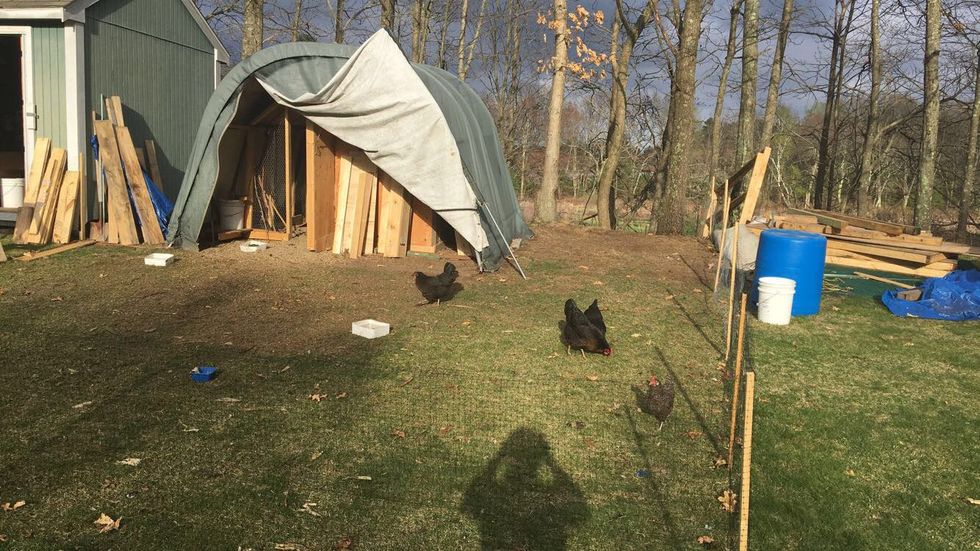The picture at the top of this article is a picture of my own chickens. We have four: Elmira, Gwendolyn, Thyra and Goli. I can tell them apart by the different feather patterns each one of them has, and can even tell their eggs apart. On the weekends, they have free reign of our one acre yard, because we're all home and can watch and make sure they don't get into mischief. During the weekdays, they stay in this very large enclosure, and they have twelve hours minimum of free roaming time seven days a week, no matter the weather. Inside their tent, they have a fully enclosed coop with insulation in the walls and an electric heater for the winters so they don't get cold, and a fan during the summer so they don't get too hot. They have ten nest boxes to choose from, and a tall platform where they can roost at night. They're fed a mixture of protein-rich organic chicken feed with corn scratch, pumpkin seeds and fresh herbs that my dad hand-mixes himself. They have two bowls of water outside which is changed daily, and they have a hanging feeder and water trough inside their coop for the night. They eat grass, worms, and the occasional ant hill when they can find it hidden in the woods, and have access to ample dirt where they can take dirt baths to clean their feathers or cool off in the hot weather. In return, they each lay an egg a day for us, with yolks that are nearly orange in color because they're so fresh. This is what a humane organic, cage-free chicken farm looks like.
Unfortunately, this is not what most other chicken farms look like, no matter what they claim. In fact, most "cage-free" chicken farms that claim their operation is superior because their chickens aren't confined to cages, are some of the worst farms out there. Their chickens are kept in huge barns, sometimes nearly a thousand hens to a barn, and never see a glimpse of sunlight their entire lives, never mind eat fresh grass or breathe fresh air. But because they're not kept in small cages, per se, they're considered the humane alternative to larger farm operations.
And it's not just chickens that get this treatment. People forget that farm animals are just as susceptible to animal abuse as cute puppies and small kittens are. Dairy farms, pork farms and chicken hatcheries are all prime breeding ground for some of the most inhumane conditions an animal can experience in their lives. They're confined to cages, they're milked or slaughtered without a care for their well being, and no one says boo because they're only farm animals, after all, and are meant to be eaten anyway. Not like the cute dog at the shelter, or the mother cat who was abandoned with her kittens; those animals are pets, and therefore have much more value than a farm animal who would be killed for food anyway.
These harmful opinions on the differences between worthy and unworthy animals is why such heinous acts of cruelty are allowed to be committed against farm animals. It's why most chickens don't live longer than two to three years, even though a healthy chicken's life span can be anywhere from eight years to fifteen years old.
My four chickens live a pretty happy life; they come when they hear my voice, usually looking for a snack, and they love sitting on my knee when I sit outside to watch them on the weekends. We recently added eight more hatchlings to our growing brood, and in a few weeks, they'll be ready to move outside permanently and join the flock. And in three years, when our chickens are no longer able to lay eggs, they won't be killed for meat or abandoned to a farm shelter; they're going to continue living in our backyard, fighting over worms and destroying their favorite patch of lawn and making a break for the neighbor's yard. But so many chickens living in "humane, cage-free" farms will not live such a charmed life. In fact, they'll be lucky to see their third year of life, and the thought makes me sadder than words can say.

















